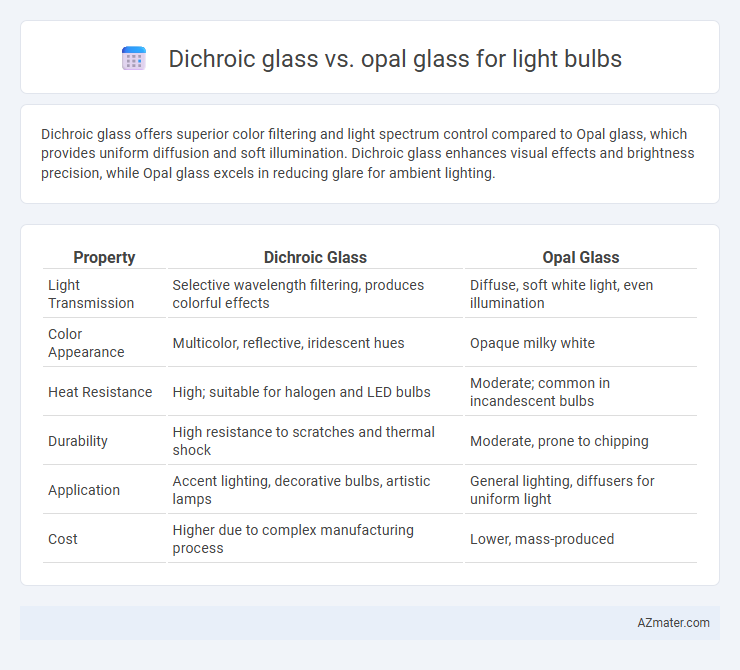Dichroic glass offers superior color filtering and light spectrum control compared to Opal glass, which provides uniform diffusion and soft illumination. Dichroic glass enhances visual effects and brightness precision, while Opal glass excels in reducing glare for ambient lighting.
Table of Comparison
| Property | Dichroic Glass | Opal Glass |
|---|---|---|
| Light Transmission | Selective wavelength filtering, produces colorful effects | Diffuse, soft white light, even illumination |
| Color Appearance | Multicolor, reflective, iridescent hues | Opaque milky white |
| Heat Resistance | High; suitable for halogen and LED bulbs | Moderate; common in incandescent bulbs |
| Durability | High resistance to scratches and thermal shock | Moderate, prone to chipping |
| Application | Accent lighting, decorative bulbs, artistic lamps | General lighting, diffusers for uniform light |
| Cost | Higher due to complex manufacturing process | Lower, mass-produced |
Introduction to Dichroic and Opal Glass
Dichroic glass consists of multiple micro-layers of metal oxides that reflect specific wavelengths of light while allowing others to pass, creating vibrant color effects and efficient heat rejection in light bulbs. Opal glass, also known as frosted or milk glass, diffuses light evenly to reduce glare and produce a soft, uniform illumination commonly used in residential and commercial lighting. Both materials enhance lighting aesthetics but serve distinct functional purposes: dichroic glass offers color filtering and heat management, whereas opal glass focuses on light diffusion and softness.
What is Dichroic Glass?
Dichroic glass is a specialized material that reflects certain wavelengths of light while allowing others to pass through, creating vivid color effects ideal for light bulbs and decorative lighting. It consists of multiple ultra-thin layers of metallic oxides deposited on glass, enabling precise control over light reflection and transmission. Compared to opal glass, which diffuses light uniformly, dichroic glass offers enhanced color separation and sharper light beams for artistic or functional lighting applications.
What is Opal Glass?
Opal glass is a type of frosted or milky-white glass commonly used in light bulbs to diffuse light evenly, reducing glare and producing a soft, uniform illumination. It is made by adding opacifying agents such as bone ash or tin oxide during the glass manufacturing process, creating a translucent effect that helps enhance visual comfort. Compared to dichroic glass, which filters specific wavelengths of light for color effects, opal glass prioritizes light diffusion and neutrality, making it ideal for general lighting applications where a warm, consistent glow is desired.
Light Transmission and Color Effects
Dichroic glass offers superior light transmission with selective wavelength filtering, resulting in vibrant color effects and enhanced brightness for light bulbs. Opal glass diffuses light more evenly, producing a softer, uniform glow with reduced glare but lower overall light transmission. The choice between dichroic and opal glass depends on whether color intensity or diffused illumination is desired.
Aesthetic Differences in Lighting
Dichroic glass produces vibrant, multi-colored reflections and prismatic effects that create dynamic, colorful lighting, making it ideal for decorative and artistic lighting fixtures. Opal glass emits a soft, diffused glow that evenly distributes light, resulting in a gentle, muted ambiance preferred for residential and mood lighting. The aesthetic difference lies in dichroic glass's intense, sparkling illumination versus opal glass's smooth, soothing light quality.
Durability and Heat Resistance
Dichroic glass exhibits high durability and superior heat resistance, making it ideal for light bulbs exposed to intense temperatures and prolonged use. Opal glass, while offering excellent diffusion and aesthetic appeal, generally has lower heat resistance and is more prone to thermal stress and cracking under high temperature conditions. Choosing dichroic glass enhances lifespan and performance in demanding lighting environments, whereas opal glass suits applications prioritizing soft light diffusion.
Energy Efficiency Comparison
Dichroic glass in light bulbs reflects heat while allowing visible light to pass, reducing energy loss and enhancing energy efficiency by minimizing wasted heat. Opal glass diffuses light evenly but tends to absorb and emit more heat, leading to lower energy efficiency compared to dichroic glass. Energy-efficient lighting fixtures often prefer dichroic glass for its ability to improve luminous efficacy and reduce cooling costs.
Applications in Lighting Design
Dichroic glass in lighting design enhances color rendering and directs light precisely, making it ideal for architectural and theatrical applications requiring dynamic visual effects. Opal glass diffuses light uniformly, reducing glare and creating soft, ambient illumination suited for residential and commercial spaces focused on comfort and aesthetics. The choice between dichroic and opal glass depends on whether the application prioritizes color control and light direction or even, diffused lighting quality.
Maintenance and Longevity
Dichroic glass used in light bulbs offers superior heat resistance and durability, resulting in lower maintenance needs and longer lifespan compared to opal glass, which is more prone to discoloration and cracking over time. The reflective coating on dichroic glass enhances light efficiency while maintaining structural integrity under thermal stress, reducing the frequency of bulb replacements. Opal glass, though aesthetically pleasing with its diffuse glow, often requires more frequent cleaning and replacement due to its susceptibility to surface damage and decreased translucency.
Choosing the Best Glass for Your Light Bulb
Dichroic glass offers superior color separation and heat resistance, making it ideal for decorative and high-performance light bulbs where vibrant color effects and durability are essential. Opal glass provides a soft, diffused light that reduces glare and creates a uniform glow, perfect for general lighting applications requiring comfort and aesthetic appeal. Selecting the best glass depends on whether enhanced color quality or gentle illumination is the priority for your lighting needs.

Infographic: Dichroic glass vs Opal glass for Light bulb
 azmater.com
azmater.com